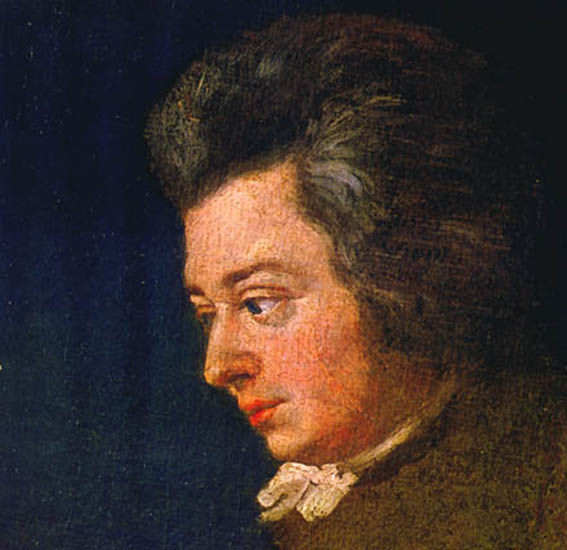Wolfgang Amadeus Mozart (1756-1791)
Born January 27, 1756 in Salzburg, Austria.
Died December 5, 1791 in Vienna, Austria.

Sinfonia Concertante, K. 364 (320d)
Composed Summer, 1779.
Instrumentation: Solo Violin, Solo Viola, 2 oboes, 2 horns, Violins I & II, Viola, Violoncello, Bass.
Duration: ~ 30 minutes.
Mozart loathed working for the Archbishop of Salzburg, Hieronymous Colloredo. In 1777, he petitioned for release from his duties. This led to both him and his father being fired. With the added pressure of providing for the entire family, Mozart and his mother then travelled to Paris, with stops in Munich and Mannheim. Once again, he failed to find employment on this 2 year tour. Even worse were his personal losses on the trip. His mother died in Paris 1778 after a short illness. Then, on way back from Paris, he stopped again in Munich to visit the Webers, and especially Aloysia with whom he was infatuated in Mannheim. Aloysia, like the nobles who refused him employment, was not interested in a former child prodigy and failed composer. (Mozart later married Aloysia’s sister Constanze.) It was a defeated Mozart who returned to Salzburg where he was forced to beg the Archbishop for his old job back.
With Mozart back in Salzburg instead of touring and writing copious letters back home, we have a less detailed account of the genesis of the Sinfonia Concertante. The work was most likely written by the 23 year old composer during the summer of 1779. It is also likely that Mozart himself played the viola part for the first performances as playing the violin was one of his less than favorite duties as Colloredo’s servant.
At that time, the symphonie concertante was a popular form in Paris. It is similar to the Baroque concerto grosso, but places more emphasis on the soloist, or soloists, rather than treating them and the orchestra as equals. The middle class in Paris was growing in importance. It was for them rather than the nobility and their courts that these works were written, offering composers and soloists an opportunity to display their talents outside the courts. Given Mozart’s experience with Colloredo, this was quite appealing. The Sinfonia Concertante is the only complete work by Mozart in this genre; he abandoned four other attempts. (There is the Symphonie Concertante for Winds, K. 297b, which was discovered in the 20th century, but it was not in Mozart’s handwriting. There is debate as to its authenticity.)
It was common for composers to leave it up to the soloists to provide their own cadenzas in which they could display their technique, although with two soloists the task of improvising a cadenza would be daunting, to say the least. While the score to the Sinfonia Concertante is lost, we do have fragments which include fully notated cadenzas for both the first and second movements.
The influence of the Mannheim orchestra is apparent throughout the work. The opening Galant fanfare is quite similar to Mannheim composer Karl Stamitz’s symphony beginnings. The exposition is brought to a conclusion with an effective use of the “Mannheim Rocket” and crescendo.
Mozart departs from the French symphonie concertante, not only by adding a movement to the usual two, but also writing the middle movement in a minor key. As is common with Parisian symphonies concertante, the first movement does not limit itself to the usual sonata two- theme format. Instead it is overflowing with melodic ideas, including a Mannheim “sigh” played by the violin. (m. 17).
The middle movement is slow (andante), with an emotional underpinning to the chords that looks forward to Don Giovanni, displaying the character of an intimate dialogue between the soloists.
The presto finale is in the traditional symphonie concertante rondo, in which a theme returns between divergent episodes. The introspection of the andante is left behind as the work ends in a burst of joyful energy.
As a note of additional interest, the Sinfonia Concertante is written in Eb major but the solo viola part was written a semitone lower in D major. This procedure is called “scordatura”, the Italian word for “mistuning”. In this case, the viola would have tuned all of its strings up one-half step. While this would have made the technical facilitation of playing the notes much easier, modern players simply transpose the part to Eb.
Resources
Public Domain Score at IMSLP.
Kremer, Kashkashian, Harnoncourt.
Stern, Zukerman, Mehta.
[amazon template=iframe image&asin=B00000E3CK][amazon template=iframe image&asin=B000001G6M][amazon template=iframe image&asin=B00000E6M0]
One Reply to “Mozart: Sinfonia Concertante, K. 364”